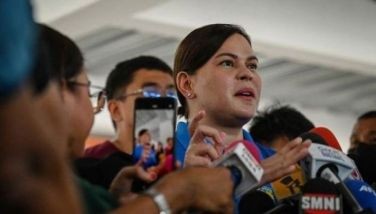London calling

I was only able to visit the National Art Gallery upon landing in London because I had to go to the University of Nottingham for the External Examination Board meetings. The series of meetings is to make sure that the high bar of standards set by the home school in the UK are met by the University of Nottingham campuses in China and Malaysia.
I took the train from the cavernous King’s Cross station, which seemed cleaner and more spruced up than I remember it in 1993. I took a picture of the neon image of a man and a woman locked in an embrace, saying goodbye to each other. It was chilly, and naturally, I had three layers of clothes to ward off the cold.
The train arrived on time and left on time. This was what I learnt in my stay before in the UK. Be on time for the departures and arrivals of buses and trains and even of planes, for if you are late by ten minutes, then you would have to wait for the next ride to arrive.
Comfortable and clean the train coaches were, and I sat down and looked outside as the train began to move out of King’s Cross. My first stay in the UK had trained me to look at the English landscape rolling past the windows. In greater London it was buildings and houses, less sooty now than I remember them, more modern buildings being built and more cars crowding the streets.
The hills began to roll before me when we left the city. It was the middle of June and harvest had been over. No bales of hay were piled one of top of the other; no small cottages stood like dots in the horizon. Just the rise and fall of the hills, the green grass seemingly neatly buzzed, like heads with newly cropped hair.
We reached Nottingham after two and a half hours. A kind man helped me with my luggage, since the lift was not working. An omen I thought it was, but the gentleman helped me bring my luggage all the way to the taxi rank. I took a black cab, smaller and modern that the grand, old cabs of memory, and soon we were moving on the way to my hotel in the suburbs.
Nottingham looked like a typical English city with its tall buildings made of brick and formed in the shapes of spires. There were new and modern buildings, standing beside the old ones, but there seemed to be a harmony about them.
I stayed in a small bed-and-breakfast hotel on the edges of the city. It was small, clean and comfortable. It also stood primly near a tram station, so I did not have difficulty reaching the city. My friends were wary that I chose a hotel so far from the city centre, but I told them I had lived in the United Kingdom before, and would certainly find my way around the city.
The University of Nottingham’s main buildings sit on a green hill fringed with flowers, because summer was in full bloom. There was a tower with a clock, the way it was in the Asian campuses in China and Malaysia. I meet my fellow academic staff from the School of English, and I was struck by the high quality of their creative writing and research, and the efficient and professional way they did things.
The External Examination Board meetings went well, and I was happy to hear good words about the examination questions prepared by my academic staff in Malaysia, by the way the questions were framed, as well as the papers written by the students, marked as they mostly were with intelligence and depth.
My fellow professors also brought me to dinners and lunches, where I ate varieties of continental and British cuisine (I loved roast). Dr Carina Hart, who was teaching with us in Malaysia, also brought me to the series of man-made limestone caves that ran under the city of Nottingham. The caves were so small we had to bend our heads mostly on the way down the steps hewn out of limestone.
The guide – a cheerful one with lore and laughter – led us to several set pieces that showed the way of life in Nottingham centuries ago. There was a display of tannery, where dried and tanned skins from pig, cattle, horse and other animals were hung on walls. Later, I asked Carina if there was another guide, for standing behind me in a corner was another man in coarse tunic seemingly from another century, face unshaven and hair unkempt.
She told there was none, with her eyes widening. And later, I asked her if there were two other women beside the well, trashing animal skins on the flat rocks to soften them, and she said there were none. I must have been imagining things, but I described to her what the people wore, and she did assure me that those costumes belonged not to this century, but to the people who must have inhabited the limestone walls, centuries ago.
Another set-piece was a recreation of the cave during the Second World War, complete with siren wailing, thick gas masks and hard benches. One of the old man with us made a running commentary of how it was during the bombing, when war planes from Nazi Germany would have blitzkrieg missions on the cities of England, dropping bombs in the middle of the night.
These were the same bombs, I thought, that must have fallen and shook whatever equanimity was left in the mind of the formidable English writer Virginia Woolf. With a family history of mental illness and riven with fear that she would surely not survive the war, one day she just put stones in the pocket of her dress, walked into the river that flowed beside her house, and drowned. The only thing she left was a farewell letter to her husband Leonard, and her brilliant books filled with words of gladness, and of grief.
Comments can be sent to [email protected]
- Latest
- Trending




























